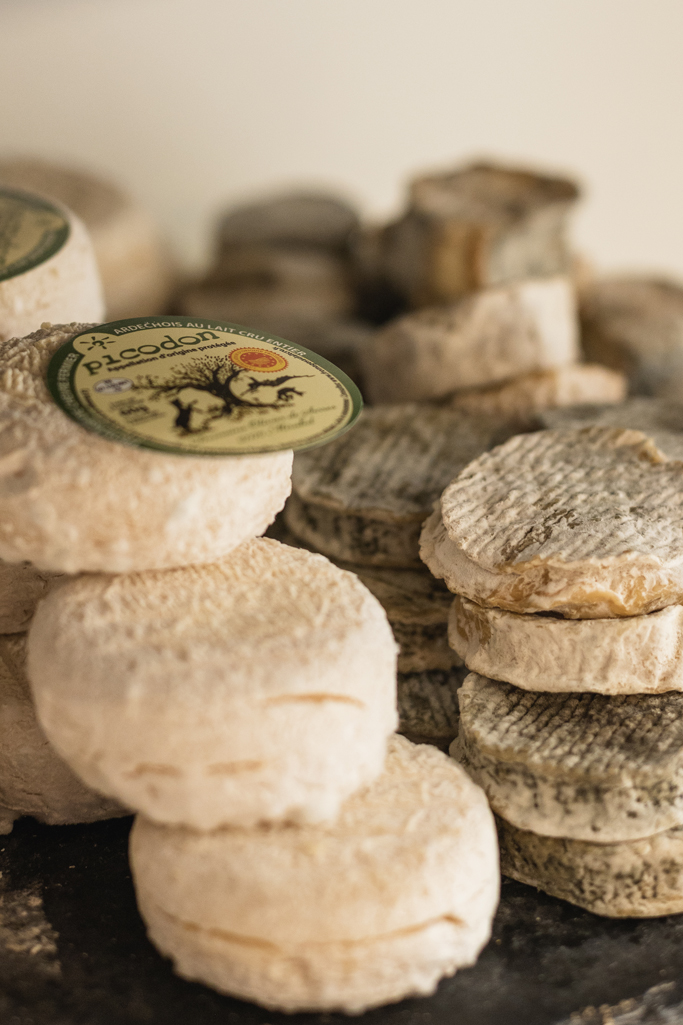Located in the centre of Reims, ‘Fromages et Vins du Boulingrin’, is a destination that features in the little black book of every self-respecting foodie. Just a stone’s throw from Boulingrin central market hall, the shop lists more than 300 cheeses and 800 wines and champagnes to the delight of fine food enthusiasts. At the helm, Marion and Rémy Bonnard, two ardent foodies who work tirelessly on a daily basis to offer a carefully curated selection of France’s finest cheeses. Maison Abelé 1757 was treated to an exclusive inside look into the specialist retailer, while taking the time to savour an exquisite journey of the senses.

Could you introduce yourselves and tell us about the history of your establishment?
The business was launched 8 years ago by two old friends, Philippe and Armelle Cahour. When they first opened the shop, there were very few specialist food retailers in rue de Mars. This has changed dramatically over time, and the area has carved a name as a well-known food destination. Two years ago, the opportunity came up to take over ‘Fromages et Vins du Boulingrin’.
Prior to this major career change, I worked in pharmaceuticals, where part of my job was to entertain clients at BtoB events. My husband was a farmer.
Philippe and Armelle, the previous owners, were planning to move to Brittany. As for us, the idea of trying our hand at something completely different was beginning to take root. Having discussed this at length with my husband, we agreed to take over the business.
For this to work, I had to retrain, and enrolled on a professional course firstly in cheese, and secondly in wine. I completed this dual-qualification on a part time basis in Paris, while at the same time working in the shop to learn the ropes, backed by a sound theoretical and professional grounding.
To what do you owe the success of your cheese shop?
We struggle with the term ‘success’. Our key objective is to make our customers happy and provide a really warm welcome. We take time to get to know our customers, to understand what they like, and to build an extensive and impressive range of cheeses. For us it is really important to make them feel they are much more than just the Average Joe. In return, we gain their trust, and that’s the best gift we could ever wish for.
What criteria come into play when selecting a cheese producer?
We base our decisions on the person and the product. More than anything, it’s the initial contact with the producer. It’s about relationships, understanding the cheesemaker and his craft. From our perspective, we are looking to support the cheesemakers by listing their produce. And then there’s the instant appeal for a cheese on tasting, and seeing how it fits within our range. Finally, there’s unpasteurised milk. This is a raw product that is going to become increasingly rare given the challenging weather conditions we are facing.
Like a restaurant curates and maintains its wine list, how have you built your cheese cellar?
We start with the needs and wants of our clientele. When a customer enters our store, they are generally looking for originality, either for a cheese board to serve with pre-dinner drinks or at the end of a meal. Which means our window displays have to be really engaging, showcasing our top 10 cheeses including Saint-Nectaire, Emmental and Comté.
Next, we look to combine a range of different milks and textures, such as goats’, sheep and cow’s milk. Some of our customers lean towards creamy cheese, others prefer more pressed. This diversity brings a wealth of variety to a cheeseboard.
Finally, length of ageing will also create different nuances on the palate. We often advise customers to start with a goats’ cheese and finish with a much stronger cheese. It’s important to have a selection of different textures and flavours to stimulate the tastebuds.

Making fine Champagne starts with the vine. What about making cheese?
You have to remember that the producers who craft the cheese have to take all the credit. Without the producers, we wouldn’t be here now. We have complete faith in their craftsmanship. Notwithstanding our insistence on longstanding tradition and quality.
Shortage of supply is an increasing problem in light of severe weather conditions. Further to continued drought, it is impossible to meet the strict regulations governing the production of PDO cheese (Protected Designation of Origin). As a consequence, producers are forced to resort to alternative feeds for their livestock instead of natural grazing, resulting in cheese delivering a less intense spectrum of flavours.
Yet animal welfare must remain at the very top of our agenda. This is evident through our discussions with producers, who feel very strongly about their livestock, and about passing on their skills to future generations.
Cheese is a food that has already been processed before reaching the end consumer. Do you think we should alter it further or leave it as is?
Personally speaking, I prefer cheese au naturel. Some delicatessens offer a range of new cheeses such as Saint-Nectare with pecans. It’s quite fun from a tasting perspective, but I tend to prefer the authentic product. It’s a kind of respect in some ways, for the cheese and the producer. The producer has channelled his love and attention into crafting the cheese in a certain way, creating a specific flavour profile. Cheese is a living material which will age and improve with time.
From serving temperature to how to cut and combine different cheeses, what are the key elements to master in order to serve the ultimate cheese board?
There are a few rules to follow, such as having an odd number of cheeses on the platter, or cutting the cheese in a certain way. When your guests help themselves to cheese, it is important to have a reasonable proportion of rind and cheese. This way the last in line won’t be left with only a piece of rind on their plate! (she laughs).
Ideally, you should stick to a certain order when tasting cheese, as a rule of thumb commencing with the mildest cheeses to the left of the platter, then placing the cheeses in a clockwise direction in order of intensity. You could start with a fresh goats’ cheese and finish with a 30-month-old Comté. It is important not to overwhelm the palate and build the intensity gradually in order to appreciate the flavour of each cheese.
What would be your ideal cheese platter to accompany Sourire de Reims Rosé Champagne?
When we put together cheese and champagne pairings, we apply the same tasting principals. Sourire de Reims Rosé is a very fruity champagne. To balance the flavours, you could opt for a mature cheese. A 30-month-old Comté or a Munster would work perfectly. Both the champagne and the cheeses are superb products that work together in perfect harmony, without either element overpowering the other.
How does time influence cheese and quality of flavour?
It’s all a question of taste, as not all our customers’ palates are the same. Some customers really appreciate the chalkiness, and lactic acid quality of a young, lightly matured brie. Cheese is a living product that matures over time. The longer the cheese is left to work its magic, the greater the intensity of flavour.
The best example of this is a pressed cheese like Comté. The longer you leave it, the more crystalline deposits form in the cheese (Tyrosone). There’s a slight crunch to the cheese on the palate. Fans of Blanc de Noirs Champagne will particularly appreciate Comté served with fine champagne. Thanks to our master cheesemakers, we are fortunate to be able to offer a range of cheese at every stage of maturity to satisfy every palate.
On a more personal level, what is your relationship with time?
My relationship with time changes markedly depending on the day of the week. On a busy weekend, stress levels tend to increase and allowing me less quality time to spend chatting and tasting with customers. At the end of the day, we are in the food business and it seems vital to maintain this notion of discovery and pleasure.
When a customer pulls a face and asks for information on a cheese, we always use the same approach: get them to taste the product. It’s the best way to dispel any pre-formulated opinions. We are all about introducing new cheeses and flavours to our customers, and in some cases, opening their minds.
























